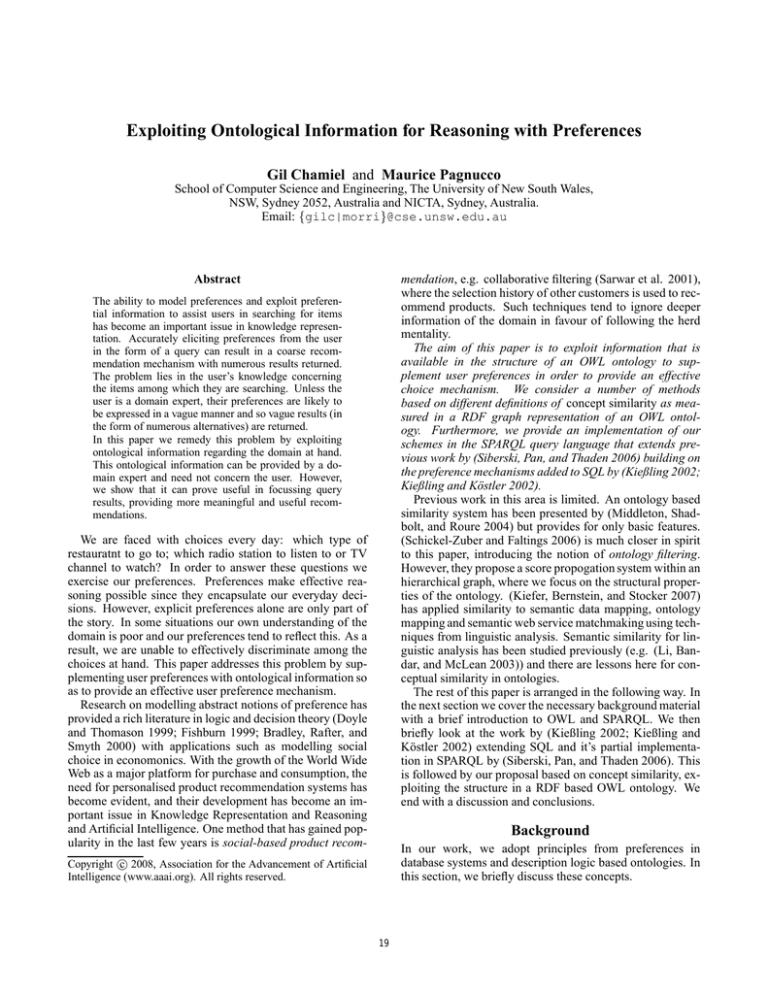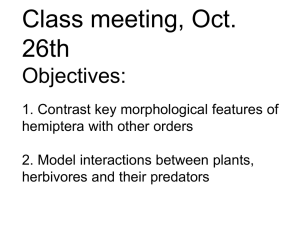
Exploiting Ontological Information for Reasoning with Preferences
Gil Chamiel and Maurice Pagnucco
School of Computer Science and Engineering, The University of New South Wales,
NSW, Sydney 2052, Australia and NICTA, Sydney, Australia.
Email: {gilc|morri}@cse.unsw.edu.au
mendation, e.g. collaborative filtering (Sarwar et al. 2001),
where the selection history of other customers is used to recommend products. Such techniques tend to ignore deeper
information of the domain in favour of following the herd
mentality.
The aim of this paper is to exploit information that is
available in the structure of an OWL ontology to supplement user preferences in order to provide an effective
choice mechanism. We consider a number of methods
based on different definitions of concept similarity as measured in a RDF graph representation of an OWL ontology. Furthermore, we provide an implementation of our
schemes in the SPARQL query language that extends previous work by (Siberski, Pan, and Thaden 2006) building on
the preference mechanisms added to SQL by (Kießling 2002;
Kießling and Köstler 2002).
Previous work in this area is limited. An ontology based
similarity system has been presented by (Middleton, Shadbolt, and Roure 2004) but provides for only basic features.
(Schickel-Zuber and Faltings 2006) is much closer in spirit
to this paper, introducing the notion of ontology filtering.
However, they propose a score propogation system within an
hierarchical graph, where we focus on the structural properties of the ontology. (Kiefer, Bernstein, and Stocker 2007)
has applied similarity to semantic data mapping, ontology
mapping and semantic web service matchmaking using techniques from linguistic analysis. Semantic similarity for linguistic analysis has been studied previously (e.g. (Li, Bandar, and McLean 2003)) and there are lessons here for conceptual similarity in ontologies.
The rest of this paper is arranged in the following way. In
the next section we cover the necessary background material
with a brief introduction to OWL and SPARQL. We then
briefly look at the work by (Kießling 2002; Kießling and
Köstler 2002) extending SQL and it’s partial implementation in SPARQL by (Siberski, Pan, and Thaden 2006). This
is followed by our proposal based on concept similarity, exploiting the structure in a RDF based OWL ontology. We
end with a discussion and conclusions.
Abstract
The ability to model preferences and exploit preferential information to assist users in searching for items
has become an important issue in knowledge representation. Accurately eliciting preferences from the user
in the form of a query can result in a coarse recommendation mechanism with numerous results returned.
The problem lies in the user’s knowledge concerning
the items among which they are searching. Unless the
user is a domain expert, their preferences are likely to
be expressed in a vague manner and so vague results (in
the form of numerous alternatives) are returned.
In this paper we remedy this problem by exploiting
ontological information regarding the domain at hand.
This ontological information can be provided by a domain expert and need not concern the user. However,
we show that it can prove useful in focussing query
results, providing more meaningful and useful recommendations.
We are faced with choices every day: which type of
restauratnt to go to; which radio station to listen to or TV
channel to watch? In order to answer these questions we
exercise our preferences. Preferences make effective reasoning possible since they encapsulate our everyday decisions. However, explicit preferences alone are only part of
the story. In some situations our own understanding of the
domain is poor and our preferences tend to reflect this. As a
result, we are unable to effectively discriminate among the
choices at hand. This paper addresses this problem by supplementing user preferences with ontological information so
as to provide an effective user preference mechanism.
Research on modelling abstract notions of preference has
provided a rich literature in logic and decision theory (Doyle
and Thomason 1999; Fishburn 1999; Bradley, Rafter, and
Smyth 2000) with applications such as modelling social
choice in economonics. With the growth of the World Wide
Web as a major platform for purchase and consumption, the
need for personalised product recommendation systems has
become evident, and their development has become an important issue in Knowledge Representation and Reasoning
and Artificial Intelligence. One method that has gained popularity in the last few years is social-based product recom-
Background
In our work, we adopt principles from preferences in
database systems and description logic based ontologies. In
this section, we briefly discuss these concepts.
c 2008, Association for the Advancement of Artificial
Copyright Intelligence (www.aaai.org). All rights reserved.
19
Preference Querying in Database Systems
Querying Ontological Information
In the context of database systems, (Kießling 2002) presents
a framework for dealing with preferences as soft constraints,
named Preference-SQL. In this work, preferences are seen
as strict partial orders over database tuples i.e. as transitive and irreflexive preference relations. It proposes an extension to the SQL query language (Kießling and Köstler
2002) which permits filtering the result set using soft constraints as opposed to classical SQL filtering which adopts
hard constraints returning only those results that match the
query exactly. A partial syntax of the extended query language is given below:
SELECT
<projection-list>
FROM
<table-reference>
WHERE
<hard-conditions>
PREFERRING <soft-conditions>
ORDER BY
<attribute-list>
Using this syntax, the user can express their preferences as
soft constraints and will receive tuples which best match
those constraints. This approach is referred to as the BMO
(Best Match Only) query model in which a tuple will find
its way into the final result set if there does not exist any
other tuple which dominates it, i.e. better satisfies the preference constraints. Preference constraints in this framework
can be expressed through standard SQL operators in terms
of likes/dislikes (e.g. =, <>, IN) and numeric constraints
(e.g. <, >=, BETWEEN). This work also introduces a set
of special operators which allow the user to express their
preferences in terms of numerical approximations (through
the operator AROUND which will favour values close to a
given numerical target value) and in terms of minimization/maximization of numerical values (through the operators LOWEST/HIGHEST which will accept a lowest/highest
value respectively over other values). In order to allow complex preference construction, two binary preference assembly operators are introduced:
The Pareto accumulation (AND) treats both constituent preference constructs as equal and is defined as:
x ≺P1 ⊗P2 y ⇔
(x ≺P1 y ∧ (x ≺P2 y ∨ x ≡ y))∨
(x ≺P2 y ∧ (x ≺P1 y ∨ x ≡ y))
Where x, y are database tuples and P1 , P2 are preference
constructs. Intuitively, this definition says that y is strictly
preferred to x whenever it is strictly preferred by at least
one of the two constituent preferences and equally or more
preferred by the other.
The Prioritize accumulation (CASCADE) is used to treat two
preference constructs in order of importance and is defined:
Ontologies provide a standardised way of classifying terms
related to a domain. They are central to the knowledgebased paradigm.
Description Logic Based Ontologies In recent years,
with the emergence of the Semantic Web, the importance
of knowledge representation and reasoning techniques over
ontological information has gained added significance. Ontologies (Antoniou and van Harmelen 2004) are a knowledge representation technique based on description logic
(DL) principles consisting of terminological entities, i.e.
Concepts and Properties also referred to as T Box and instances (individuals) also refered to as ABox. A very important feature of ontologies is the inherent ability to define
terminological objects in a hierarchical manner, that is, concepts and sub-concepts, properties and sub-properties.
RDF and OWL A very common methodology for creating ontological information is through the XML-based
markup langague OWL (Web Ontology Language) which
allows the construction of the different entities of an ontology based on RDF (Resource Description Framework)
graphs. In RDF, entities are represented using a triple
pattern logic. Each element in the RDF graph has to be
a literal or an RDF resource. For example, the following tag constructs an OWL class (concept) named Car:
<owl:Class rdf:ID="Car">. Here, the subject is a
class definition, the predicate is the class id and the object is
the string “Car”. Properties and Individuals can be created
in the same manner. For example, the following tag constructs a new individual Car <Car rdf:ID="Car_1">.
Suppose we have a property definition of a car’s year, the
following tag will assign the number 2005 as Car_1’s year:
<Car_1 :hasYear=2005>.
SPARQL The SPARQL query language over RDF graphs
(Prud’hommeaux and Seaborne 2006) is a W3C Recommendation and considered to be a vital tool for dealing with ontological information in the semantic web. SPARQL allows
queries over RDF Graphs using Triple Pattern Matching by
introducing variables and binding the appropriate RDF resources to the variables. A partial syntax for SPARQL is
given below:
SELECT
FROM
WHERE
FILTER
ORDER BY
<projection-var-list>
<ontology-reference>
<var-bindings>
<hard-conditions>
<var-list>
As opposed to SQL, the projected entities are variables
where the equivalent entity to a database tuple is a set of
variables also referred to as a solution binding (or a result
binding). The WHERE clause in the query is typically used
to bind variables to RDF resources while hard constraints
are given through the FILTER clause (although it is possible to perform certain filter operations through the WHERE
clause itself). The ORDER BY clause acts as a solution modifier, i.e. a solution list transformation function, which sorts
the result bindings according to the variables in a given list.
x ≺P1 &&P2 y ⇔
x ≺P1 y ∨ (x ≺P2 y ∧ (x ≺P1 y ∨ x ≡ y))
This definition says that x is strictly preferred to y whenever
it is strictly preferred by the first preference in the cascade
and otherwise it is strictly preferred by the second preference
in the cascade and equally or more preferred by the first.
Therefore, the first constituent preference in the cascade is
given higher consideration.
20
Motivating Example
Other solution modifiers offered by SPARQL are LIMIT to
limit the number of results returned and OFFSET to instruct
SPARQL to start the result set after a given number of bindings are found.
The Beer Ontology Consider an ontology which describes and stores information about beer (Figure 1). This
may include the type of beer, country of origin, alcohol level
etc. Drawn from domain-specific knowledge, beer types are
typically viewed in an hierarchical manner. It is common to
consider categorizations of beer types by the differences in
yeast used in the fermentation process. Thus, the main beer
categories are lagers (made of bottom-fermenting yeasts),
ales (top-fermenting yeasts) and lambics (spontaneous fermentation using wild yeasts). Under these categories we can
find sub-types of lagers, ales and lambics and so on. A partial beer type hierarchy graph is given in Figure 1. Note that
this information was taken from domain specific expert data
and it is not neccesary for users (beer consumers in this case)
to be aware of the different types of beer or the hierarchical
relations between them. Still this information can be readily exploited when reasoning with preferences. This domain
example was chosen in the context of this work due to the
fact that each hierarchical level defines not only a level of
abstraction but can store real objects as well. For example,
the type Dark Ale is an abstract concept (possibly defined
as a dark top-fermented beer) which other beer types (e.g.
Stout and Porter) inherit from but it is also a way of describing real objects (some beers are categorized simply as Dark
Ales). In other words, individuals (beer instances) will be
associated not only with leaf concepts but with concepts at
any level. This is a crucial point for the work presented here.
Querying Ontological Information with
Preferences
A natural progression is to extend SPARQL with preferential
queries.
P-SPARQL
In a similar fashion to the way that Kießling extended SQL
to enable database querying with preferences, (Siberski,
Pan, and Thaden 2006) presents an extension to SPARQL
to query ontological information with preferences. The fundamental idea here is similar; a new query element is introduced to allow the construction of preferences as soft constraints. The extended syntax of SPARQL (in the rest of this
paper, we refer to this extension as P-SPARQL) is given below:
SELECT
<projection-var-list>
FROM
<ontology-reference>
WHERE
<var-bindings>
FILTER
<hard-conditions>
ORDER BY
<var-list>
PREFERRING <soft-conditions>
In the preferring section, every filter operator supported by
SPARQL can be used as well as two scoring operators,
HIGHEST/LOWEST with similar semantics as PreferenceSQL. Also, similarly to Preference-SQL, two complex preference assembly methods are implemented, i.e. the Pareto
operator for treating two preference operators as equally important and the Cascade operator to prioritize one preference operator over the other. Finally, in this work the BMO
(Best Match Only) query model was adopted where a solution binding is a best match if there is no other solution
binding dominating it (i.e., strictly preferred). Each solution binding competes against every other solution binding
where a solution binding will find its way into the final result
set if it is a best match under this definition.
Example Query Consider the following P-SPARQL
query:
Prefix beer:
<http://example.com/beer.owl#>
SELECT ?id ?type ?country
FROM <http://example.com/beer.owl>
WHERE {
?id rdf:type ?type.
?id beer:hasCountry ?country.}
PREFERRING
?country = beer:Australia
CASCADE
?type = beer:DarkAle
Exploiting Hierarchical Structure for
Reasoning with Preferences
In this query, we prefer Australian beers as our most important preference attribute before we prefer dark ales. In case
no such beer exists so it perfectly answers our preference
(i.e. no Australian Dark Ale exists), we argue that it will
be sensible to return an Australian beer with similar type
to Dark Ale over returning any arbitrary beer type which
happens to be Australian. Running this query through PSPARQL will have exactly the behaviour where any type of
beer will be considered equal without examining its relationship with the target concept.
One of the most distinctive properties in representing knowledge using ontologies is the inherent ability to define the
terminologies in the ontology in an hierarchical manner.
In analogue to terminologies in database systems, i.e. the
database schema, in this work we consider the terminoligcal component of an ontology (T Box) to be the part which
stores information created by experts on the domain at hand.
This assumption will then enable us to supply (possibly recommend) to the user information about individuals (ABox)
according to their preferences without having to assume a
very high level of domain knowledge on behalf of the user,
and exploit the level of knowledge the user does have in
order to perform more accurate preference querying. This
is important because in many product recommendation settings, the user possesses little if any domain knowledge.
Equality as an IS-A Relation
In Description Logic (Baader et al. 2003) concept inheritance can be viewed as an IS-A relation C1 ⊑ C0 where
a sub-concept (or property) C1 is also of type C0 by inheriting its properties and functionality. In our case, Stout
21
PREFERRING
?country = beer:Australia
CASCADE
?type ∼= beer:DarkAle
Thing
Beer
Lambic
Fruit Beer
Gueuze
Lager
Pale Lager
Dry Lager
Bock
Pilsner
Ale
Dark Lager
Stout
Dry Stout
Imperial Stout
Dark Ale
Porter
Golden Ale
Amber Ale
Pale Ale
India Pale Ale
Where ∼= is the syntactic version of the similarity operator
Sim(C1 , C2 ).
Note that by introducing a new Boolean operator we do
not change the notion of domination querying. We still have
the ability to compare two result bindings to obtain the preference domination relationship between them.
There are many ways to compute similarity between concepts in an ontology, each reflecting a different rationale.
In the rest of this section we discuss various methods and
their rationales for computing this kind of similarity measurement.
Wheat Beer
Altbier
Sweet Stout
Figure 1: Ontological Concept Hierarchy of Beer Types
will be considered a Dark Ale and thus (assuming the existence of an Australian Stout) should dominate other types
which are not a sub-concept of Dark Ale. Even though
OWL is based on description logic concepts, this behaviour
is not inherited in SPARQL. Filtering using the equal operator will return only those objects which have that particular target concept. Furthermore, the filtering option
?type rdfs:subClassOf C (for querying individuals
which have a sub-concept of some target concept C), will
result only in those that are a direct sub-class of C omitting individuals which have the type C itself (and thus not
satisfying the axiom C ⊑ C) as well as individuals which
have a type which is not directly inherited from C (and
thus not satisfing the transitivity property of the IS-A relation). The effect of the IS-A relation can be obtained
by changing the semantics of the equality operator so that
C1 = C0 ⇔ C1 ⊑ C0 . Note that querying with the ISA relation can affect not only preference querying but also
standard hard-constraint querying. Note also that treating
the equality operator as an IS-A relation will result in it being asymmetric.
However, there are still a few problems with this method:
what if there is no result under the target concept (or any
of its sub-concepts)? Should we consider all other concepts
outside the target concept as equal? Furthermore, is there
any relation between different levels within a sub-hierarchy?
Do we want to distinguish between general and specific concepts? We discuss these issues in the next section.
Similarity via Direct Graph Distance A very simple
method for measuring similarity in an ontology graph is by
looking at the direct distance between a candidate concept
and the target concept:
Sim(C1 , C0 ) =
1
Dist(C1 , C0 )
(2)
Where distance is defined as the distance of each concept to
the most recent common ancestor of the two concepts:
Dist(C1 , C0 ) = N1 + N0 + 1
(3)
Ni = len(Ci , M RCA(C1 , C0 )) and M RCA(C1 , C0 ) is
the most recent common ancestor of C1 and C0 (i.e., the
meet in lattice theoretic terms). Note that the distance between a concept and itself here is equal to 1 to avoid division
by zero. The rationale behind this simple method is to consider concepts which are “closer” to the target concept more
similar. For example, a plain Ale or a Stout will be considered more similar to the target concept Dark Ale then a Pale
Lager. The main problem with this approach is the fact that
it is not consistent with the IS-A relation assumption. It may
consider concepts which are not a sub-concept of the target
concept more similar than concepts under the target concept.
This naı̈ve approach, being less intuitive, can however serve
well as a benchmark method for comparing other methods.
Similarity-based Querying
Distance and the IS-A relation Combining the two ideas
presented so far, i.e. treating a sub-concept as the target concept (the IS-A relation) and measuring similarity via graph
distance solves the above problem. (4) is a similarity measurement that will differentiate between sub-concepts and
non-sub-concepts of the target concept. Sub-concepts of the
target concept will all be equally similar to the target concept
and will always be more similar to the target concept than
those concepts “outside” the target concept. The similarity
of concepts outside the target concept will be according to
their closeness to the target concept.
(
1
if C1 ⊑ C0 ,
(4)
Sim(C1 , C0 ) =
1
if
C1 6⊑ C0 .
Dist(C1 ,C0 )
In order to expolit the hierarchical structure of an ontology,
we present here a series of methods for computing categorical similarity between concepts in a T Box. We use these
similarity methods for performing preference querying over
ontological information.
We introduce a new Boolean operator Sim(C1 , C2 ) (is
similar to):
b1 ≺P (C0 ) b2 ⇔ Sim(C(b1 ), C0 ) < Sim(C(b2 ), C0 ) (1)
Where C0 ∈ Concepts is the target concept, b1 , b2 ∈
ResultBindings and C(bi ) is the value bound to the relevant variable in the result binding bi w.r.t C.
For example, in order to change the previous example to
prefer Australian beers and then beers similar to the type
Dark Ale, we change the PREFERRING section of our query
to:
Communicated level of specificity The previous method
considers all concepts below a target concept as equal. This
22
may well be the case for many users or in many domains
(we discuss the relevance of the different methods in the discussion section) but in some cases, the following argument
can be made: suppose a user asks for an Ale. As discussed
above, we cannot assume that the user is familiar with the
complete sub-hierarchy under Ale. In other words, we cannot assume that the user knows exactly which types of Ale
exist (we only assume that the ontology engineer and the
people in charge of data entry are experts in the field and
can be trusted). What we can assume is that our user knows
what Ale means (as opposed to other types of beer). Furthermore, if a different user asks for a very specific type of
Ale, we can now assume that he is familiar with that type
and probably looking specifically for it. If the user asking
for an Ale wanted that very specific type of Ale, he would
probably ask for it directly. In other words, we may consider
sub-concepts “closer” (and thus more general) to the target
concept because they are closer to the level of specificity the
user has communicated in their preference. The following
measure will create this effect:
(
1
if C1 ⊑ C0 ,
Sim(C1 , C0 ) = Dist(C1 ,C0 )
(5)
−Dist(C1 , C0 ) if C1 6⊑ C0 .
comparing the similarity between a general concept and a
sub-concept on depth ≥ 4 from it. For example, this method
will give a similarity measurement of 0.5 between Ale and
Lager and a smaller similarity measurement of 0.44 between
Ale and a sub-concept of Ale at depth 6 (that is, a very specific type of Ale). It may be argued that even though this
very specific type of Ale is indeed an Ale, due to its specific charateristics it may have gone far enough from the
base concept to be considered less similar to it compared to
a concept outside that base concept. We find no justification
for making such an argument mainly due to the fundumental
significance of the IS-A relation in description logic conceptual inheritance.
We propose here a method for measuring similarities between concepts while considering specific shared information more similar and preserving the IS-A DL axiom.
Most Specific Shared Information w.r.t Tree Depth In
order to measure similarity between concepts while considering concepts that share more specific information to be
more similar and preserve the DL semantics of the IS-A relation, we modify (6) by reducing the similarity measurement
in relation to the depth of the compared concepts and the
maximal depth of the tree. In order to keep the method symmetric, we look at the average distance of the two compared
concepts to the depth of the tree:
Most Specific Shared Information So far we have concentrated on the similarity between sub-concepts under the
target concept. We saw different ways of treating this information. Another very important issue when dealing with
hierarchical-based similarity methods is the similarity between the different concepts not inherited from the target
concept and that target concept. Consider the following
query over our beer ontology: the user has asked for a Stout
(possibly among other criteria). There is no Stout or a subconcept of a Stout which satisfy the request. We do consider
an Ale and a Porter. Up until now, these two concepts will
be considered as equally similar to Stout (both with distance
3 from Stout). The problem here is that it may well be argued that Porter is more similar to Stout than a plain Ale
since Stouts and Porters share more specific information.
Both Stout and Porter inherit from Dark Ale which means
that they share the special properties of a Dark Ale that distinguish it from a plain or any other type of Ale. (Wu and
Palmer 1994) presented a similarity measurment (in the context of linguistics) which takes the level of shared information into account:
2 ∗ N3
Sim(C1 , C0 ) =
(6)
N1 + N2 + 2 ∗ N3
Sim(C1 , C0 ) =
2 ∗ N3
N1 + N2 + 2 ∗ N3 + AV G
(7)
Where N1 , N2 and N3 are defined as in (6), AV G is the
average distance of M AX to the depth of the concepts C0
and C1 and M AX is the length of the longest path from
the root of the ontology to any of its leaf concepts. For
2∗2
= 0.5 while
example, Sim(Stout, Ale) = 2+0+2∗2+2
2∗3
Sim(Stout, P orter) = 1+1+2∗3+1 = 0.67 and thus, as for
the previous method, Porter will be considered more similar to Stout than Ale. But now, as opposed to (6), this will
still give a smaller similarity measurement (0.24) between
Ale and Lager and a greater similarity measurement between
Ale and any sub-concept of Ale, e.g. 0.4 for a sub-concept
of Ale at depth 6. We can prove that (7) guarantees that
sub-concepts are always preferred to non-sub-concepts w.r.t
a target concept.
Theorm 1. Let ≺ be defined by (1) with Sim defined as
in (7). Let C0 , C1 , C2 be concepts in an ontology such
that C1 ⊑ C0 and C2 6⊑ C0 . For all result bindings b1 ,
b2 such that C(b1 ) ∈ C1 and C(b2 ) ∈ C2 it holds that
Sim(C0 , C1 ) > Sim(C0 , C2 ) (hence b2 ≺P (C0 ) b1 ).
Where N1 , N2 are the distances from the concepts C0 and
C1 to their MRCA respectively and N3 is the distance
from this MRCA and the root of the ontology (assuming
the most general concept is the OWL concept Thing). In
2∗2
our example, Sim(Stout, Ale) = 2+0+2∗2
= 0.67 while
2∗3
Sim(Stout, P orter) = 1+1+2∗3 = 0.75 and thus Porter
will be considered more similar to Stout than Ale and will
dominate it in the context of beer type.
A major drawback in using this method to compute similarities in ontology hierarchies is that it does not respect
the IS-A relation axiom on ontologies with depth > 4 when
The powerfulness of this method is that it encapsulates
both discussed intuitions while preserving the symmetric nature of (6). It stands in the IS-A relation axiom, always considering sub-concepts of a target concept more similar than
non-sub concepts w.r.t a target concept. It also considers
concepts that share more specific information more similar
unless the previous statement does not hold.
23
Implementation
having to possess a deep understanding of the underlying domain. In particular, we adapt one similarity measure (6) and
introduce another (7). Ontologies are developed by domain
experts who have intimate knowledge of their subject area
and are exploited by naive users who can specify weaker
preferences without the fear of being overwhelmed by the
results. Moreover, the results are not biased by the whims of
previous user consumption but by exploiting domain expertise. Our proposals are implemented on ARQ and enhance
the SPARQL standard.
An implementation of the methods proposed here have
been completed based on the ARQ SPARQL query engine
(Seaborne 2005) (a Jena based query engine) and building
on the implementation of (Siberski, Pan, and Thaden 2006)
where the iterative processing of preference querying is performed as a solution modifier (similarly to the way the classical sorting functionality ORDER BY is done). On top of
the described similarity measurement methods, we complemented this implementation by adding some further numerical preference attributes mentioned in (Kießling and Köstler
2002) such as AROUND and BETWEEN. In order to give the
user the flexibility in choosing their preference query semantics w.r.t similarity, the system receives two parameters:
equality operator semantics (strong equivalence or IS-A) and
a similarity measurement method.
References
Antoniou, G., and van Harmelen, F. 2004. A Semantic Web
Primer (Cooperative Information Systems). MIT Press.
Baader, F.; Calvanese, D.; McGuinness, D. L.; Nardi, D.;
and Patel-Schneider, P. F., eds. 2003. The description logic
handbook: Theory, implementation, and applications. New
York, NY, USA: Cambridge University Press.
Bradley, K.; Rafter, R.; and Smyth, B. 2000. Case-based
user profiling for content personalisation. Lecture Notes in
Computer Science 1892:62–72.
Doyle, J., and Thomason, R. H. 1999. Background to
qualitative decision theory. AI Magazine 20(2):55–68.
Fishburn, P. 1999. Preference structures and their numerical representations. Theor. Comput. Sci. 217(2):359–383.
Kiefer, C.; Bernstein, A.; and Stocker, M. 2007. The
fundamentals of iSPARQL – A virtual triple approach for
similarity-based semantic web tasks. In ISWC ’07.
Kießling, W., and Köstler, G. 2002. Preference SQL: design, implementation, experiences. In VLDB, 990–1001.
Kießling, W. 2002. Foundations of preferences in database
systems. In VLDB, 311–322.
Li, Y.; Bandar, Z. A.; and McLean, D. 2003. An approach for measuring semantic similarity between words
using multiple information sources. IEEE Transactions on
Knowledge and Data Engineering 15(4):871–882.
Middleton, S. E.; Shadbolt, N. R.; and Roure, D. C. D.
2004. Ontological user profiling in recommender systems.
ACM Trans. Inf. Syst. 22(1):54–88.
Prud’hommeaux, E., and Seaborne, A. 2006. SPARQL
query language for RDF. Technical report, W3C Candidate
Recommendation.
Sarwar, B. M.; Karypis, G.; Konstan, J. A.; and Reidl, J.
2001. Item-based collaborative filtering recommendation
algorithms. In World Wide Web, 285–295.
Schickel-Zuber, V., and Faltings, B. 2006. Inferring User’s
Preferences using Ontologies. In AAAI 2006, 1413–1418.
Seaborne, A. 2005. ARQ - A SPARQL processor for Jena.
http://jena.sourceforge.net/arq.
Siberski, W.; Pan, J. Z.; and Thaden, U. 2006. Querying the
semantic web with preferences. In International Semantic
Web Conference, 612–624.
Wu, Z., and Palmer, M. 1994. Verb semantics and lexical
selection. In 32nd Annual Meeting of the Association for
Computational Linguistics, 133 –138.
Discussion
We have described here various similarity meaurement techniques to be used in the context of preference querying. How
should one choose a method in order to utilize this for their
own purpose? Furthermore, who should bear the responsibility of deciding on the different parameters in this system?
We briefly discuss these issues here.
In terms of the similarity method applied, apart from the
different rationale encapsulated in the different methods, it
is important to distinguish between two different inheritance
systems: Abstract Inheritance Systems and Data Inheritance
Systems. Abstract inheritance systems define an hierarchical
system in which data objects (individuals) are attached only
to leaf nodes. The intermediate levels in the hierarchy serve
as abstract concepts (and thus are not used for instantiation).
For example, suppose we have an hierarchy over the different programming languages according to some features
of those languages. Java may inherit from the concept Object Oriented Language but this concept cannot be used for
instantiation of a specific program (a program will eventually be written in a specific language). This abstract concept
can be used for reasoning purposes. In data inheritance systems, non-leaf nodes also often define an abstraction over
their child concepts but instances can be associated with any
concept in the hierarchy. An example of a data inheritance
system is our beer ontology. We argue that this distinction
should be taken into consideration when selecting a similarity measurement method. For example, pure distance based
methods (2) and (5) will not perform well on abstract inheritance systems while IS-A relation based methods will perform better on those systems.
Conclusions
In this paper we have enhanced preference querying by supplementing the user’s preferences with ontological information; in particular, by exploiting the structural properties of
the ontology describing the domain at hand. We claim that
this is significant for a vast class of ontologies that we refer
to as data inheritance systems. By introducing a notion of
similarity based on distance metrics, we free the user from
24





